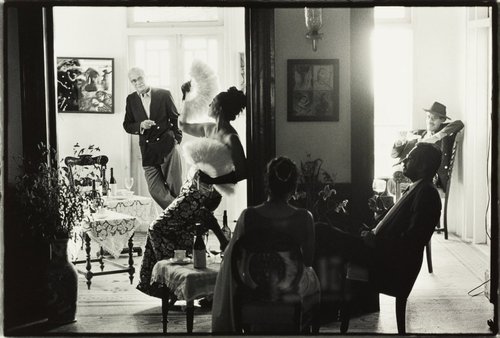-
Details
- Place where the work was made
-
India
- Date
- 1996-1998
- Media category
- Photograph
- Materials used
- selenium toned silver gelatin prints
- Edition
- 5/10
- Dimensions
- 27.94 x 40.64 cm image; 40.64 x 50.8 cm sheet
- Credit
- Purchased with funds provided by the Asian Art Collection Benefactors 2021
- Location
- Not on display
- Accession number
- 169.2021.4
- Copyright
- © Pushpamala N.
- Artist information
-
Pushpamala N.
Works in the collection
- Share
-
-
About
'The Phantom Lady is fragile, solitary figure fighting the demons, adventuring, gung ho, yet melancholy. The city slips away in its shadows, elusive, and enigmatic.' Pushpamala N
Pushpamala N was born in Bangalore in 1956. When she was a student in Baroda in the late 1970s and 80s she was influenced by the Narrative painting movement and particularly the work of Bhupen Khakhar. While she was practicing sculpture in the 1990s, her interests moved towards photography and video due to the influence of her then husband, the film scholar Ashish Rajadhyaksha and their circle of associates from the Film Institute in Mumbai. Pushpamala casts herself as the protagonist in many of her photographic works, addressing issues relevant to feminism, social politics and Indian history.
This series of 25 photographs are staged performances, based on the concept of photo romances. Like comic strips serialised in magazines or newspapers, they are placed in a sequence to tell a story. Inspirations for the characters include the well-known Phantom comics first created in New York, but which were published in the 'Illustrated Weekly of India' in the 1940s. Another reference is the masked hero in early films such as the 'Mark of Zorro' in 1920, whose style of costume was popular in early Indian movies.
In 'Phantom Lady or Kismet', Pushpamala alludes to the masked character known in Indian cinema as Fearless Nadia. Famous for her roles in a number of films including 'Hunterwali' (meaning ‘a woman with a whip’) of 1935, Fearless Nadia was in fact an Australian actress and stuntwoman named Mary Ann Evans. She was born in Perth in 1908 and went to Bombay (Mumbai) in 1913 with her father’s regiment. Although she was fair haired and obviously Caucasian, there was no reference to her heritage in the Hindi-language film. 'Hunterwali' brought huge fame to Evans and its makers, the Wadia brothers. In India Evans learnt horseback riding, ballet, joined the circus and sang Hindi songs on stage. It was JBH Wadia, the stunt film producer of Wadia Movietone Bombay, who wanted to make films with strong women characters, and who gave Evans the name Fearless Nadia. She became one of the most famous film stars in India during the 1930s and 40s celebrated as playing an ‘Indian avenging angel’.
'Phantom Lady or Kismet' utilises a black and white film noir style of the early detective film genre. In the staged photographs, Pushpamala plays both protagonists: the phantom lady and the vamp – the good woman and the bad woman. These women, who sit on either side of the law, play out the story in the gangster ruled dark streets of Bombay. The story is set amongst the colonial architecture of the city as a reminder of its past, part of which included drug trade from China, and immigrants coming from foreign shores. The secret underworld in this imagined Indian metropolis of unseemly characters is enhanced by the dark mood that pervades the images.
-
Places
Where the work was made
India
-
Exhibition history
Shown in 1 exhibition
Correspondence, Art Gallery of New South Wales, Sydney, 10 Sep 2022–2024
-
Bibliography
Referenced in 1 publication
-
Melanie Eastburn, Look, 'Elemental', pp. 34-41, Sydney, Aug 2022-Sep 2022, 41.
-
-
Provenance
Pushpamala N., 1996-2021, Sydney/New South Wales/Australia, purchased from the artist through Chemould Gallery, Mumbai by the Art Gallery of New South Wales, Sydney, October 2021.




